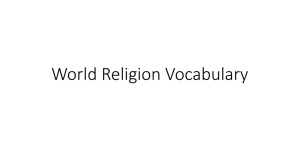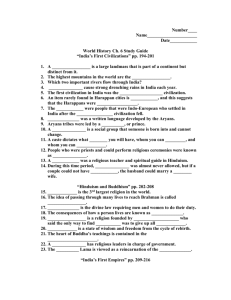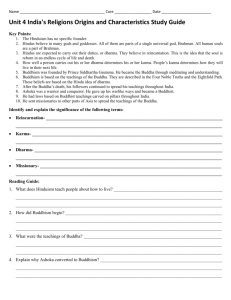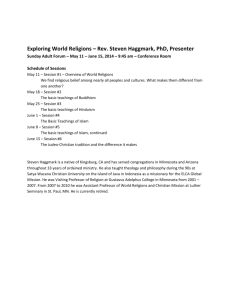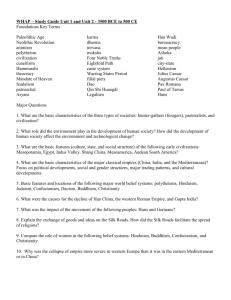CULTURES AND RELIGIONS IN SOUTHERN AND EASTERN ASIA
advertisement
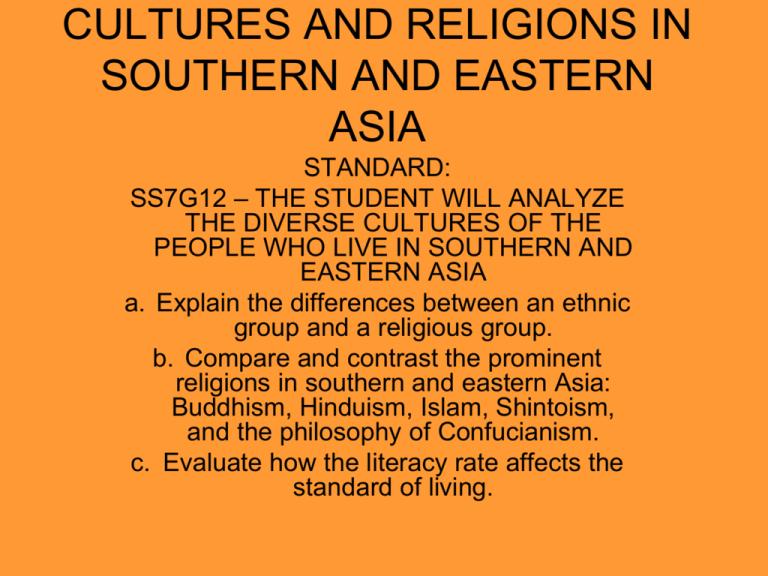
CULTURES AND RELIGIONS IN SOUTHERN AND EASTERN ASIA STANDARD: SS7G12 – THE STUDENT WILL ANALYZE THE DIVERSE CULTURES OF THE PEOPLE WHO LIVE IN SOUTHERN AND EASTERN ASIA a. Explain the differences between an ethnic group and a religious group. b. Compare and contrast the prominent religions in southern and eastern Asia: Buddhism, Hinduism, Islam, Shintoism, and the philosophy of Confucianism. c. Evaluate how the literacy rate affects the standard of living. Different religions and ethnic groups • Southern and Eastern Asia is made up of a blend of various religious and ethnic groups. • Ethnic groups like the Chams of Vietnam, Tagalog of the Phillipines, and Javanese of Indonesia. • Different religious groups like Buddhists, Muslims, and Hindus as well as Shintoists and Confucianists Religious group vs. Ethnic Group • Religious Group – group made up of common beliefs. Can have different languages, cultures, and race. They may be spread over many countries. • Ethnic Group – group made up of people with similar language and culture. They may or may not share religious beliefs or values. Usually of the same race with common ancestors. Buddhism • Originated in Northern India • Fourth largest religion in the world. • Siddhartha Gautama was the first “Buddha” or “enlightened one” • Traveled all over India spreading his teachings and philosophies and gathered a following. • Buddhists do not believe in a god. • They follow the teachings of one man “Buddha” • Basic ideas of their beliefs include: Buddhist Teachings • 1. The Four Noble Truths – basic instructions that say suffering exists in the world and humans must reach enlightenment to rise above the sufferings. • 2. Holy Book – Tripitaka – tells Buddha’s teachings. • 3. Man worship – they do not worship a god, but they instead thank Buddha through reading the tripitaka to become more enlightened. • 4. Ultimate Goal – Nirvana – a state of enlightenment where one can achieve peace and happiness through meditation. • 5. Reincarnation – a belief in a cycle of birth and rebirth. They believe one’s behavior in this life determines what they will be in the next life. • • • • • • • • • The Silk Road The Silk Road began about the 5 th to the 4th centuries BC. Traders used this road to carry goods to and from Asia and Europe. It included many branches, rather than just one direct route. Many middlemen were involved in the trade occurring over the 4,000 mile route. Traders would never travel the entire route with their goods. Camel caravans were used to transport goods along the Silk Road. It was the longest road on Earth. The Silk Road started in Xi’an, in northwestern China & ended in Antioch on the Medditerrian Coast The journey was difficult, dangerous, and long. The Products and Ideas that Traveled the Road People at each end of the Silk Road, as well as along the way, wanted to trade their goods with each other. Crops from western Asia went to China, and glass from Europe and cotton cloth from India traveled to China. The Chinese traded silk with the rest of Asia and Europe. Europeans also wanted spices. Asians wanted wool, gold, and silver from the west. Buddhism spread along the Silk Road. Travelers as well as local people liked the Buddhist idea that thought their present life is full of suffering, the cycle of birth, death, rebirth, and suffering can be broken by following Buddhist ideas and practices. The Road’s Importance • Traders used the Silk Road until a safe sea route from Europe to Asia was possible. • A safer and faster water passage route connecting Eastern Europe to India and China had to be found. • Then, instead of getting goods via the middlemen of Central Asia, European traders could buy spices and other goods from East Asia directly, and then sell them in European markets. • Once the sea-routes started in the 15th & 16th century, the Silk Road fell into disuse. Hinduism • It is the oldest religion. • Around1500 BC, Aryan people migrated to the Indus Valley, where Pakistan is today (Hindu means Indus) • Hinduism does not have any founder or any prophets, and it does not come from the teachings of one man. • By 4th c. BC, Hinduism had spread through all of India. • As it spread, Vedic Hinduism mixed with local religious practices. Hinduism • Largely practiced in India • 80% of Indians proclaim to be Hindus. • Believe in many gods and goddesses who are images of a single god. • They worship two goddesses the most: Vishnu and Shiva Hindu Teachings • A person’s Karma (good or bad behavior) determines their place in life. • Ultimate Goal – achieve moksha (freedom from the cycle of reincarnation) • They do not have one sacred text. • They read many texts called the Vedas which teach them proper behavior. • They live by a Caste System – The system divides people into classes. The top class is the Brahmans (priests), Kashatriyas (soldiers), Vaishyas (merchants), and Shudras (laborers). THE CASTE SYSTEM •began 3,000 years ago •when Aryans took over India they thought of themselves as superior and the conquered Indians as subordinate so started the class system •untouchable (AKA dalits) is the lowest class that deals with sweeping the streets, handling dead people and animals, and tending to pigs that feed on the village garbage; they must live away from the others and are not permitted to use the village wells •it divides the population into hereditary (passed from one generation to the next) social groups •1) Brahmin (priest), 2) Kshatriya (soldiers), 3) Vaisya (merchants & farmers), 4) Sudras (laborers), 5) untouchable •you belong to same caste all your life; jobs are passed down from father to son •according to the rule of karma, if one is an untouchable, one has no one to blame but one’s self so instead of complaining, that person had better do a good job to move up the ladder Moksha Islam (Indonesia) • Based on the teachings of one man like Buddhism. The man was Muhammad. • He is to them the greatest prophet of their one god, allah. • Main holy book is the Quran. (Koran) • Two basic groups Shiites and Sunnis disagree on many of the basic teachings. Islamic Teachings • • • • • • Five Pillars 1. proclaim your faith 2. prayer 5 times a day 3. fasting (during Ramadan) 4. Almsgiving (charity) 5. Pilgrimage (visit to their most holy site of Mecca) Shintoism • Unique to Japan • Has not spread to other parts of the world like the others. • Basic structure says everything in nature contains Kami (or the spirit of a god). • Has no rules for moral living and no concepts of a single ruling god. Shinto Teaching • Expected to be reverent to nature, life, birth, and fertility. • Teaches physical purity is more important than moral purity. • They build shrines and worship their ancestors who they believe became Kami (spirits) when they died. • Shinto is often practiced along with another religion because it has no rules of moral living or a god of its own. • When entering a shrine, a follower passes through a Tori, or gate – this symbolizes movement from the human world to the world of the gods Philosophy of Confucianism (China) • Not really a religion according to some but a philosophy. • Comes from the teachings of one man. • Confucius supposedly created a moral structure for social life and politics that every man should follow. • Does not teach of one true ruling god. Teachings of Confucianism • Each person has his or her place in society. • Each person should accept his or her place so society can function well. • 5 basic types of relationships where one must accept whether they are superior or inferior: – Ruler and subject – Father and son – Husband and wife – Older brother and younger brother – Friend and friend Rulers are to be respected as long as they are fair and care for the people. Family relationships are essential to having good society and family respect is the foundation of all ethics. •The Asian people have always considered the family to be the most important part of society. •The individual thought of himself as a member of the family. •If the individual was successful, the prestige of the family was increased but if the individual was a failure, that brought shame on the whole family. •Arranging marriages was the responsibility of the parents. •The bride and groom had little to say about the choice of their mate or marriage arrangement. •In most cases the bride had not seen her husband before. •The most difficult adjustment was to her mother-in-law as the mother-in-law was responsible for training and discipline her daughter-in-law. •Women were never considered equal to men. •When there was famine, girls were often sold by their parents who regarded them as just another mouth to feed. •Girls sometimes as young as six were often betrothed (promised marriage). •If the girl’s parents experienced bad times, she would be sent to work in the house of her future husband. •Young brides were often mistreated by their mother-in-laws. •If a woman's husband died, she was not allowed to remarry. NOW •Since after World War II, women gained equal rights with men. •Women can now seek divorce and own property. •There are little forced marriages Indian Language •Hindi is major native language, •Sanskrit is the ancient, holy language; 3,000 years old, used by upper & educated class •different language has divided India into many small states •following words come from Indian languages: bungalow, khaki, loot, pajamas, punch, thug •China is made up of many different peoples. •About 94% of the people are know as Han Chinese •The other 6% of China is made up of 55 different groups. •Most of the minorities live in the sparsely populated western China. •The minority peoples differ from the Han Chinese in language, religion, race, custom, and history. •Some minorities (like Tibet) want independence, but China will probably never loosen its control over the regions because they have most of China’s natural resources. •Korea is called “The Land of the Morning Calm” •It is a peninsula nation that extends off the east coast of Asia between China and Japan •Only one-fifth of the land is suitable for farming. •The peninsula is divided into two countries, N. and S. Korea •Because of its location near China and Japan, invading armies swept through Korea many times. •The invaders settled down and intermarried with the local people. •Like Japan, Korea is homogeneous (one type) with 99.9 % of its people Korean •The Korean people were united into one cultural group hundreds of years ago. •many people live in village which is the center of life •house made of bamboo and wood; roofs are steep with palm leaves •well is the place for gossip •tool shed is for everyone •wat is the village temple •under the house is where the family water buffalo lives •sleep on mats; no electricity, no running water, bathe at river •major food is broiled meat served on thin bamboo skewers (satay) •The diet and cuisine of the Japanese have been strongly influenced by geography and agriculture •Rice has always been the staple food in Japan •The scarcity of meat, together with the Buddhist taboo against the taking of animal life made the Japanese nonmeat eaters, except for fish, for most of their history. •Much of the fish in Japan is eaten raw, wither in small slices called sashimi or as sushi which combines the fish with seaweed and rice •Another source of protein besides fish is soybean which is used to make tofu Ikebana - It is the art of flower arrangement •Ikebana uses line, color, and rhythm to create floral designs Bonsai - For centuries the Japanese have developed the art of dwarfing (making things small) trees. •This is the art of bonsai which are planted in pots, are used for ornaments in rooms or to decorate a garden •Noh Play: the backdrop is often a single pine tree •In Noh plays there are usually three roles - an old man, a woman, and a samurai •Noh plays are usually short and they are presented as a group of plays with performances as long as 6 hours. •The groups plays are about subjects such as: God plays, warriorghost plays, women plays, and demon plays. •Dancing and chanting accompany the action of the plays. •Masks and beautifully designed costumes are worn by the actordancers •Bunraku is a puppet play where the puppets are nearly life-size and are very lifelike. •They are controlled on the stage by a team of three puppeteers who are visible to the audience •The puppeteer’s performances depend upon long years of practice and teamwork •The most popular type of drama for the Japanese is Kabuki •All roles in Kabuki, both male and female were until recently played by men •Actors taking feminine roles were trained from childhood to walk, talk, and behave like women. •Haiku is the simplest form of poetry •It consists of one verse with 17 syllables, spaced over three lines in a 5-7-5 pattern Standard of Living in Southern and Eastern Asia • A country’s literacy rate affects its standard of living • Better education means higher standard of living. • Countries invest in their human capital (people) by promoting better education and high expectations • Poverty has a major effect on a country’s literacy rate Literacy rates in Southern and Eastern Asia • Highest – Japan 99% • Lowest – India 61% • In all but Japan, females are less literate than males • Comes from traditional beliefs about women’s place in the home. • Japan’s males and females have an equal literacy rate.

